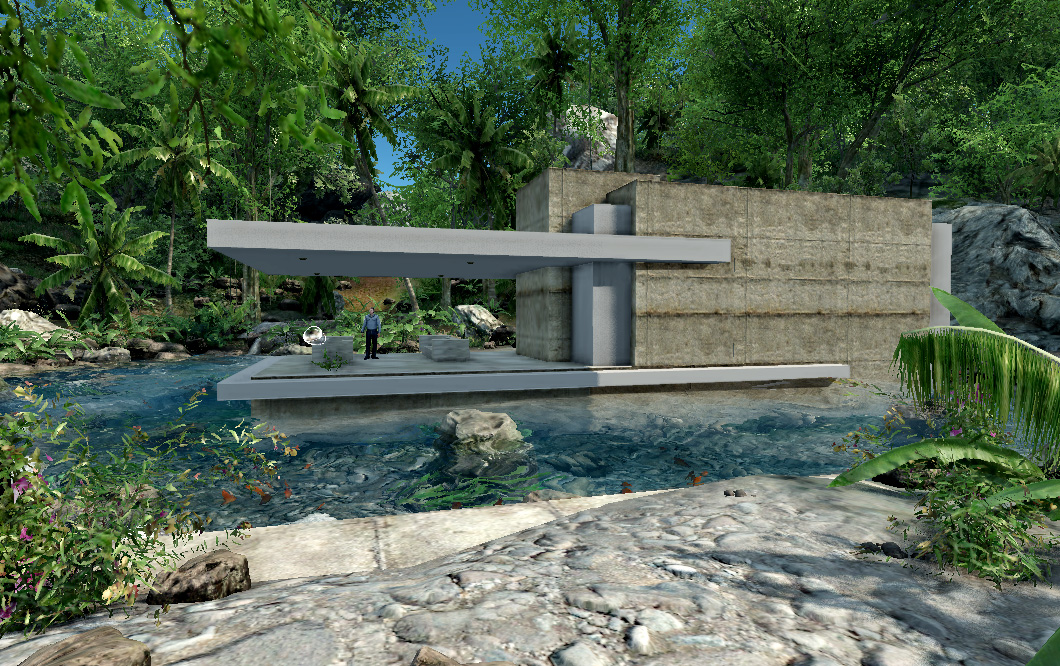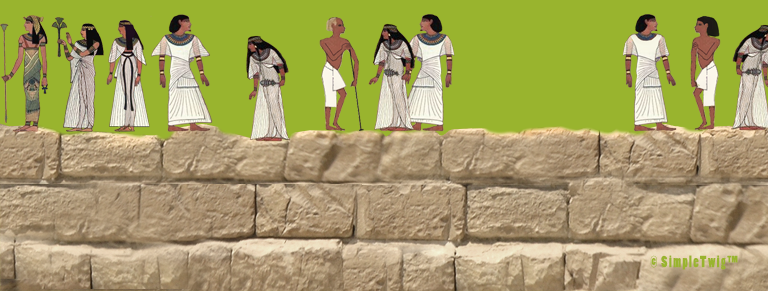Each new thing a person learns is one block in their own Pyramid of Knowledge. That is, when they learn about how to cross a street, they’ve earned one block. Every block builds upon another and is reinforced over time. Without this core knowledge continual reinforcement one’s pyramid can crumble.
You can then tell them how big your pyramid is, and how yours is still growing (learning is a life-long thing for everyone), and how big you think their pyramid is based on their knowledge and what they’re learning. I think it’s a great way to put the entire learning process in perspective for them as it gives kids a visual for what it is they’re doing, and your role as a parent to teach them new things.
This concept also includes, that while your child may know a basic knowledge of a topic, thus their ‘block’ is small, as they learn more on that topic their block increases it’s size (and density) and is able to hold more weight above it (as you learn more topics new blocks are added to the pyramid to make it taller).
I must say that I enjoy having my child tell me what she is now learning in fourth grade without me having to pry it out of her. It has given us another open door to communication and me the opportunity to expand on the topics she tells me about.

Image Credit: An original digital model and rendering by SimpleTwig Architecture of Djoser’s Stepped Pyramid, called the Wave Pyramid by N. Buccalo, for use by Know The Fundamentals. You can learn more about this topic as authored by NBuccalo at WikiVersity’s Ancient Egyptian Monuments Project and more specifically Djoser’s Step Pyramid in Saqqara which has a wealth of information.
It takes time to learn, and, time to build.
The process of learning a new topic takes time, first there is the introduction to that topic, then the process itself until there is enough knowledge that it becomes understood and remembered. Thus, a beginning, middle and end. Even after the end though one can expand that base knowledge.
This process is much like being at a quarry, roughing out a block of stone and placing the block on a ship, then sailing that block down the Nile River to it’s destination, the pyramid, and putting it into place. While on the Nile, the rough block is honed and shaped until it is smooth enough to be placed in it’s location. That trip, from the quarry to the pyramid is when knowledge is attained by the individual. It’s a trip that we all take day after day our entire lives.
Some people’s pyramids are tall and strong, some people’s are weak and fragile. It all depends on the attitudes of the individual on how they view knowledge and if they have the means and knowhow to acquire it. If they are determined to acquire it, then that trip will be focused and the resulting block will be significantly strong. If on the other hand the individual isn’t motivated, the block might be rough or warped, porous and full of ‘holes’ and result in a weak structure barely capable of holding it’s own weight. If it is weak, the ability for the individual to stack future blocks on it comes into doubt. This is one reason children shouldn’t miss school. If they do and don’t make an effort to catch up, the knowledge they need to build a solid block comes into doubt and their ability to build on that knowledge becomes much more difficult.
Certainly no one can make each block solid of everything they’ve been introduced to as each individual has their own set of inner strengths. Civilization compensates for this though by having a huge variety of needs in the job market. It is again a matter of parental choice as to what you hope for your child and how well they are motivate their children to learn. Hopefully the Pyramid of Knowledge concept will be a tool that will help.
Nodes
While the blocks analogy is good visual to relate to, the truth is the brain is composed of a thing that’s more like nodes (blocks) that are connected by pathways. This allows information and knowledge to freely flow between the different parts of what we know and what we wish to create. What would be considered a node is probably more like a series of smaller nodes, kind of like a star cluster, and the ability to see them, the light path, is the pathway that allows us to see other clusters, galaxies, individual stars, dust, planets, etc. that all form the universe, and in a way, form our brain and how we think.
If a new born was placed in a white room with no interaction to anything, perhaps not even light, sound, touch, smell, you have to wonder if any nodes would develop. Because we have our senses, and are flooded with huge amounts of information every second of every day, our brain sorts that information out in meaningful ways, so we can use it to, walk around, look, talk, touch, etc. It is all spectacular, if you don’t mind me saying, and worth protecting.
Why is this ‘Pyramid of Knowledge’ concept important as it relates to safety?
To know what you need to know to live a life void of tragedy, you need to have a strong core of knowledge on the topic. If only one piece is missing, you could put yourself in harms way without even knowing it. Without the knowledge of safety, that is well planted in the brain of every individual, we all stand the risk of having our lives cut short. There are no guarantees in life, but there are high and low probabilities. I personally hope to live in a low probability of something tragic happening, as I suspect most wish, given a choice.
Every child has the ability to absorb so much, as their brain matter is still forming. I like to think of learning a new thing as building strong pathways in the brain that allow the information to flow easily, like traffic’s ability to go from one city to another easily if the highway is large enough. It is an opportunity that parents shouldn’t miss, but given their own daily struggles can be easily overlooked. Here on Know the Fundamentals we hope to remind parents of the things they should introduce their children to. This way a child has the building blocks on many safety topics planted like seeds in their memory. With further nurturing those individual blocks, each representing a particular topic, will grow stronger. Eventually when they are adults themselves it will be much easier for them to pass on the knowledge to their children.

After we are born, our minds are exposed to the outside world. Any parent knows that the learning process for a new mind takes time as displayed by the baby’s recognition of certain things around them, or as their ability to do things increases. Each component of learning can be considered a ‘block of knowledge’ as an example, and with time those blocks have the potential to absorb more knowledge that can be applied to the world by the ‘owner’. As they absorb knowledge they expand and at the same time become ‘less porous’ and thus stronger, allowing them to support new knowledge that is exposed to the user. If the core knowledge is weak, it will be less likely to support new knowledge. If the progression of learning isn’t linear, and skips around too much, it will be harder for the mind to categorize the knowledge and place it in it’s right location resulting in a more deformed block.
No one’s pyramid is perfect and no blocks within everyone’s pyramid are perfect, but instead the result acknowledges the unique personalities of those particular individuals. In the end society appreciates and rewards the uniqueness of everyone, in order to have the specialties we all need to provide us with the things we need to have a better life.
Cores of Knowledge
There are several important blocks of knowledge within each of us. They together form the core of everything we know, and themselves branch out to other tidbits of additional knowledge. For instance, there is our family block, movement block, language block, sight, touch, hearing, tasting blocks, etc. ever branching out into new places of learning, but it is where the core is that is fundamental to all future knowledge. One of these fundamental blocks is safety, security and fear. These are what partially ties us to our family blocks when we are young. Of course safety, being the topic of this blog becomes important to our topic. Suffice it to say that safety must be taught from an early age, with the fundamentals, and continued to and through our adult age. This is important because without a solid understanding of everything we should and must know, we run the risk of putting ourselves or others into danger without fully appreciating that we are doing so.
It is obvious by my example that some people’s blocks of knowledge will be stronger, larger than other people’s. With this in mind everyone will see people, especially in crowded metropolitan areas, taking unnecessary risks. But because anything else we do in life hinges on our ability to successfully navigate our lives in a healthy way, i.e. without crippling injury or death, it seems prudent for everyone to make their best effort in strengthening their knowledge on the topic, and in fact I believe it is a responsibility not as much for the individual that risks their own life, but for those who carelessly risk the lives of others.
I feel strongly enough about this concept that I think schools, at the beginning of every year, should reinforce a developing curriculum for children, so that their strong knowledge regarding safety will ultimately be the thing that allows them a full and rewarding life. Without it, the rest, math, science, music, etc. may become pointless.
Attitudes
Everyone has their own unique attitude towards learning. I think most will accept information that will help them, like safety, if it doesn’t make them look un-cool. At one extreme end of the spectrum, you’ll find individuals that take safety as part of their life’s work, at the other end you find people ‘stumbling’ through life not giving it any real notice, unless something tragic happens. Most, I think lean, towards the stumbling side of things, while operating in what they believe is in a safe manner. This allows us to appear to live in a very safe world as real accidents seem few and far between.
Beliefs
Some people will believe that what ever happens, happens. It’s all in the hands of someone or something else, so why worry, go ahead and stumble. Everyone has the right to their beliefs unless it affects the safety of others who have the right to believe in what they want. I.e., don’t tread on other people and have enough respect for everyone to not do so.
Even people with extreme beliefs I don’t think go around tempting faith with reckless behavior. Only sociopaths may not care if they run someone over.
Psychologic Behaviors
One must admit that not everyone has the basic fundamental abilities, including how their brain works. Certainly driving while intoxicated will impair the brain’s ability to respond in an alert fashion, and for that matter stay alert just to function in a normal way. When walking around, don’t think that everyone is operating on the same level. Understand that while most of the time you’ll remain safe and without being in a close call, but at the same time trust your own eyes to insure that you won’t cross paths with someone who isn’t fully there.

